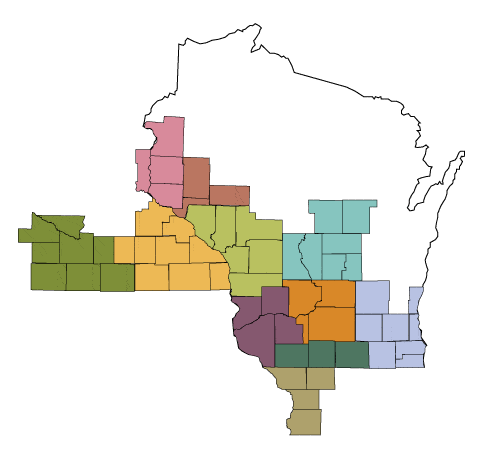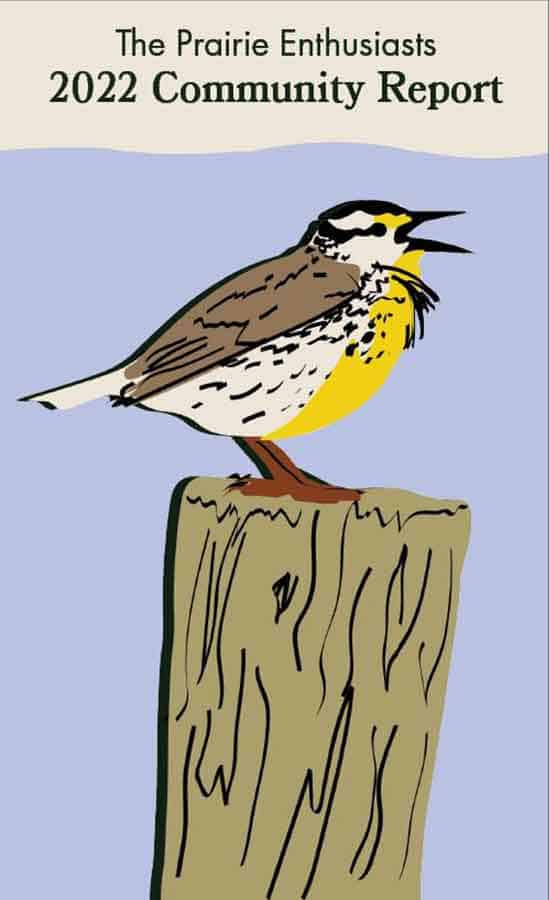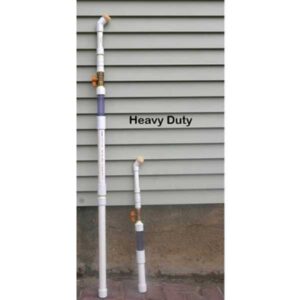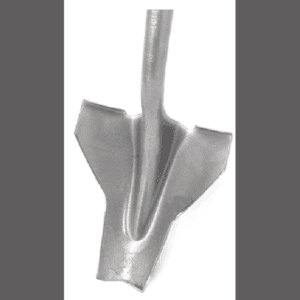Who We AreSylvie Rising Operations Assistant...
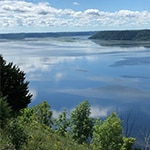
Another Bluff Prairie Saved in The Driftless Area
Another Bluff Prairie Saved in The Driftless Area
By Sarah Barron
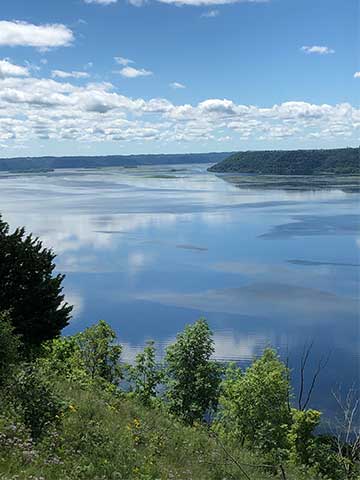
View of the Mississippi River from Marowski Bluff Prairie
“I’m very happy to save this unique piece of land as it represents not only disappearing habitat but also the very character and uniqueness of the Driftless Area.” — Dr. Marowski, the generous landowner preserving a prairie for future generations.
Ferryville, WI — When Dr. Marowski, a cardiologist living near Milwaukee, stood upon a steep bluff above the town of Ferryville, he was in awe of the stunning view. The Mississippi River, blue and majestic stretched below him, and to the north and south, the unique and ancient landscape filled the horizon. At his feet, he took notice of prairie flowers rarely seen any more and quickly understood the conservation value of the property.
The diversity of life this bluff prairie holds will now be stewarded forever. In December 2023, Dr. Marowski generously arranged for the protection of his 11-acre property by The Prairie Enthusiasts, ensuring the land will be stewarded and enjoyed for generations to come. Additional support from Mississippi Valley Conservancy, the Natural Resources Foundation of Wisconsin and Wisconsin’s Knowles-Nelson Stewardship Program helped make this protection project possible. Dr. Marowski also gifted The Prairie Enthusiasts with a land management endowment, which will provide resources to steward the habitat far into the future.
Stewardship of this prairie already began back in July of 2022. Working with Dr. Marowski, The Prairie Enthusiasts Coulee Region Chapter began restoration work on the bluff prairie. Volunteers removed some areas of sumac, red cedars and other aggressive vegetation from the site. There was already a healthy plant community there, with prairie plants like dwarf blazing-star and leadplant, as well as various birds, insects and reptiles that live on the site. The stewardship work that started and will continue in perpetuity will ensure this rare prairie ecosystem thrives.
This land, now named Marowski Bluff Prairie, is situated between Rush Creek and Sugar Creek State Natural Areas and contributes to an important protection corridor linking them together. Even though the remnant prairie at the site is in outstanding condition, it will need consistent land stewardship to remove and prevent tree and woody brush encroachment, which can shade out prairie plants. Part of that stewardship will be returning fire to the site using prescribed burns at regular intervals. The Prairie Enthusiasts Coulee Region Chapter invites the public to participate in upcoming work parties no matter what your experience level. Work parties will be scheduled this winter as weather permits. Additional volunteer opportunities and field trips will be available in the future. Details about work parties and field trips will be posted on the events calendar on our website at ThePrairieEnthusiasts.org.
About The Prairie Enthusiasts
The Prairie Enthusiasts is an accredited land trust that seeks to ensure the perpetuation and recovery of prairie, oak savanna, and other fire-dependent ecosystems of the Upper Midwest through protection, management, restoration, and education. In doing so, they strive to work openly and cooperatively with private landowners and other private and public conservation groups. Their 11 regional grassroots chapters of volunteers in Minnesota, Wisconsin, and Illinois lead projects in their local communities focused especially on high-quality remnants, which contain nearly all the components of endangered prairie communities. Find more information at: ThePrairieEnthusiasts.org
Help The Prairie Enthusiasts steward more land, provide education and more by making a donation today!
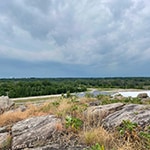
Gneiss to Meet You
Gneiss to Meet You
Exploring a Rare Prairie Growing Upon Some of the World’s Oldest Rock
Story and Photos by Addeline Theis
July 25, 2023
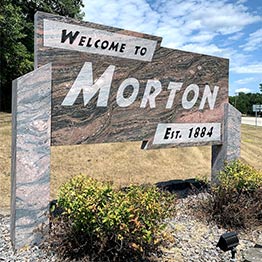
Pulling up at the edge of a gas station parking lot in the small town of Morton, Minnesota, I had to double check if this was the correct way to enter the prairie. A small foot path leading up through hip–height sumac bushes was visible from my car. It was a sign that others before me have taken this way to view the historical outcroppings. Obviously, this was my first ever visit to Morton Outcrops Scientific Natural Area (SNA). Unknowingly, I scrambled up some boulders to find myself above the landscape, overlooking the amazing river valley. Below my hiking boots were dark slabs of granite that were covered in encroaching lichen. Finding a lichen-less portion of the rock, I noticed distinctive swirling of the pink and black bands. This was the 3.6-billion-year-old Morton Gneiss (pronounced “nice”) dry prairie that the site was preserved around.
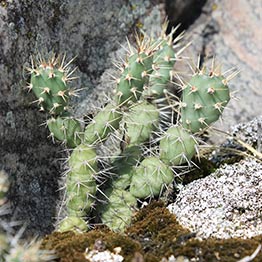
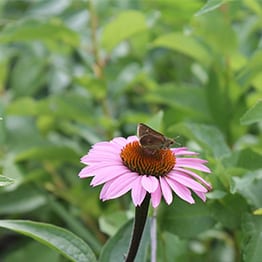
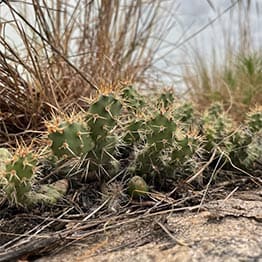
What draws geologists into this area is the events that happened after the glaciers melted. After the Des Moines lobe of the Laurentide Ice sheet retreated from southern Minnesota and the global temperature began to rise, meltwater began to collect in large inland lakes throughout southern Canada and the northern Midwest. The largest of these lakes was ancient Lake Agassiz. Varying water levels led to the lake overflowing a moraine ice dam near present day Browns Valley, creating an outlet river. Called Glacial River Warren, this outlet river was a prehistoric river that drained Lake Agassiz between about 13,500 and 10,650 BP (Before Present) years ago. The strength and power of Glacier River Warren carved out the valley that is now known as the Minnesota River Valley.
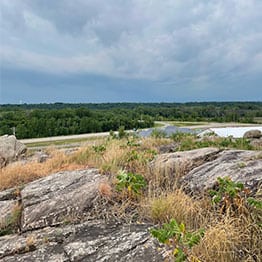
Today the land is protected as a Scientific Natural Area (SNA) managed by the Minnesota Department of Natural Resources. Colwell reflects:
When I was a boy, the Dakota story I heard was that the rock was the keeper of all knowledge. It had seen everything since the beginning of time, and if someone would ask in the correct way, they would learn the answer. It was almost like a library. I, of course, didn’t believe that story at the time. Once I started escorting geologists, anthropologists, and “ists” of all sorts through the site, I started to hear the same story repeatedly. The rock has seen everything since the earth cooled. If we look carefully and study hard, we will learn the answer to our questions.
Before returning to my vehicle, I took a few final moments on the ancient rocks, remembering that these rocks perhaps do have the answers to our questions. But only if we ask the right questions. I can only be thankful for the efforts of those that have contributed to the conservation and preservation of this site so that future generations can witness this library of knowledge within the Minnesota River Valley.

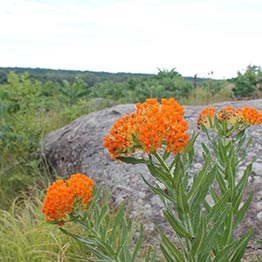
If you’re interested in dry prairies, visit one of our sites, like Muralt Bluff Prairie.
